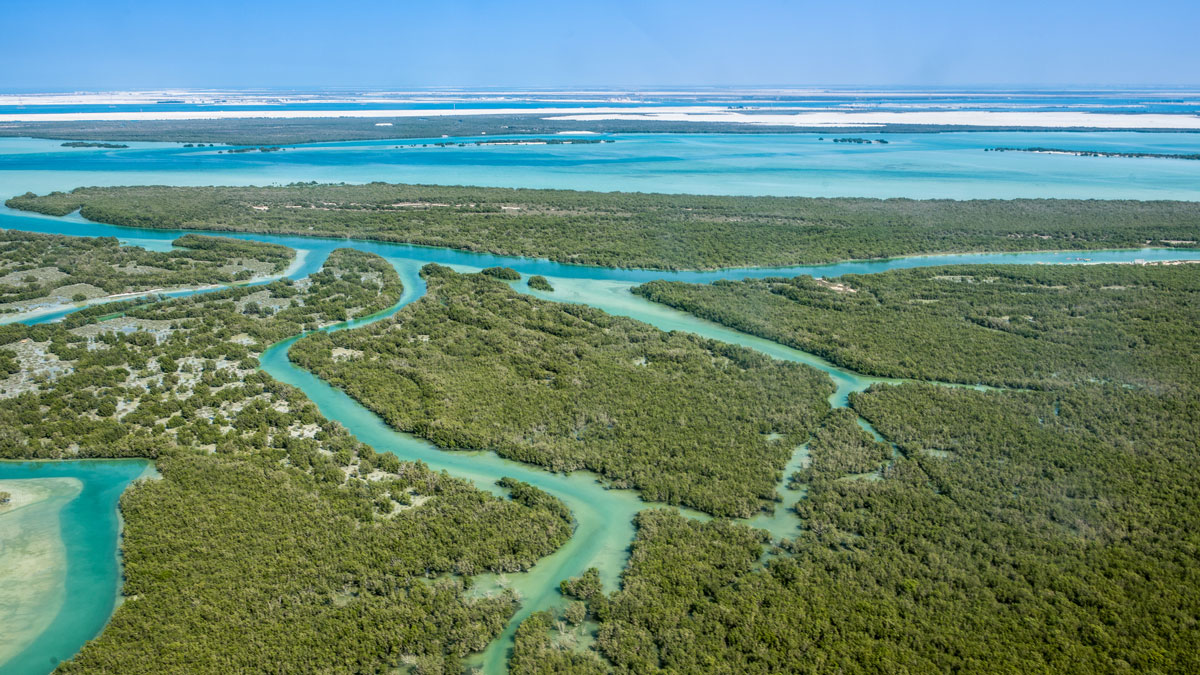Repopulating forests, planting neighborhood trees, and stopping large-scale logging are popular strategies to offset or reduce carbon emissions. But forests pale in comparison to wetlands’ carbon sequestration potential. Peatlands, salt marshes, and other coastal and inland wetlands cover just 1% of Earth’s surface, yet they store 20% of our planet’s ecosystem carbon, according to new research.
Restoring wetlands is a powerful additional tool to combat climate change, said Brian Silliman, an ecologist at Duke University and a coauthor of the study, published in Science.
Wetland Plants Hoard Carbon
Plants suck carbon from the atmosphere and use it to grow roots, leaves, and flowers. That carbon is released only when the plants decay and landscapes erode away.
The intricate root systems of partially submerged mangrove stands, salt marshes, and seagrass meadows filter material washing downstream from inland landscapes. The tangled mash of sediments and plant matter becomes the muddy embankment on which more trees and plants grow. Around 50% of the carbon buried in these environments comes from this filtered organic matter, according to the study.
Peatlands are particularly important carbon sinks. Peat moss—a primary ingredient in many boggy wetlands—grows as mats of spongy plant matter. Older peat is buried beneath newer sprouts, and in the submerged, low-oxygen environment, sluggish decay locks in thick mats of carbon for millennia.
“[Carbon] is billowing out of these degraded wetlands.”
Wetlands may be a powerhouse of sequestration and storage, but their limited area means they store a fraction of the total carbon sequestered in oceans and forests—the world’s biggest sinks, owing to their sheer size. Nevertheless, a wetland’s greater carbon density means that removing a patch of it has a bigger impact on atmospheric carbon than removing a patch of forest.
Around 1% of wetlands are lost each year to threats such as construction, farming, and sea level rise, according to the study. With the loss of these environments comes the release of their stored carbon—accounting for roughly 5% of annual total global carbon emissions. “It’s billowing out of these degraded wetlands,” Silliman said.
Moving Beyond Just Planting Trees
Although regulations to minimize wetland loss exist, “we haven’t been as aggressive as we could be in restoring them. And part of that is because we’ve underappreciated their importance in the climate crisis,” said Peter Kareiva, a conservation biologist and president and CEO of Aquarium of the Pacific, who was not involved in the study. Governments and environmental organizations have initiatives to reforest vast stretches of land, he said, but they haven’t had those initiatives at such scale for wetlands. But the recognition that wetlands are vastly more carbon rich than oceans or forests could change that.
“Everybody’s wondering how to offset their carbon: Here you go, you plant a wetland. You get a huge bang for your buck.”
“[The study] is a call to action to scale it up,” Kareiva said.
Restoring, protecting, and rebuilding wetlands can be both a global and grassroots strategy. “That’s something that people can get involved with locally,” Silliman said. “Policymakers who have bigger levers need to think about stopping the degradation of wetlands in a big way,” he added.
“Everybody’s wondering how to offset their carbon,” he said. “Here you go: You plant a wetland. You get a huge bang for your buck.”
A Shift in Wetland Restoration
The new study also suggests a change in the approach to wetland restoration efforts. Traditional conservation practices focus on limiting negative interactions among plants and their environment, Silliman said. People plant over small areas and maximize spacing between individual plants to avoid competition. But that’s the wrong approach, he said. Isolated plants have little protection from storm surges, and many are lost during planting efforts. Restoring a wetland in this way is also expensive.
Emerging research suggests that mutually beneficial interactions among plants and their environments are crucial to their survival—and to maximizing their prospects as a carbon sink. Planting wetland grasses in clumps gives them a better chance to survive because they are more protected, Kareiva said. Restoration costs go down when success rate goes up.
“If you’ve firmly established a bunch of patches, they sometimes just spread on their own,” he explained. “You don’t have to plant seedlings everywhere.”
—Jennifer Schmidt (@DrJenGEO), Science Writer

